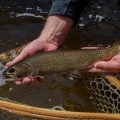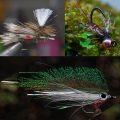How to Tie the Smokejumper
Producer: tightlinevideo
The Smokejumper is one of my favorite emerger patterns. Not only does it work exceptionally well, it’s also one of the most versatile patterns I can think of as it can be tied in a wide range of sizes, color combinations and with a variety of materials. Here, I’m going to tie a pretty basic Smokejumper to imitate a Blue Wing Olive emerger.
The fly begins with a Fulling Mill 5065 barbless Czech Nymph hook in size 18. After getting the hook firmly secured in the jaws of my tying vise, I load a bobbin with a spool of yellow olive UTC 70 Denier. Regular olive and brown olive will work for this BWO imitation as well. Get the thread started on the hook shank behind the eye and, after taking a few wraps rearward, snip off the excess tag. Leave your thread hanging at about the hook point.
Extra-small silver Ultra wire is used to rib and segment the fly, small also works well. A 6” length will make numerous Smokejumpers. Place one end of the wire against the far side of the hook and begin taking thread wraps to secure it. The wraps will push the wire to the underside of the hook. Continue taking rearward thread wraps to bind the wire there, well down into the hook bend.
Next, take touching to slightly overlapping wraps of tying thread forward to where you initially tied in the wire. Then take rearward wraps about 1/3 of the way down the body of the fly from that point. Go back up to the front of the body then again back down to 2/3’s of the way down the body. At this point, your thread is likely quite corded up. So, give your bobbin a counterclockwise spin as if you’re looking down on it, to uncord and flatten the thread. Wrap forward with the flattened thread to smooth out the body and add to its taper, which goes from thin in the back to thicker in the front. Uncord your thread as necessary to keep everything nice and smooth. End with your tying thread at the front edge of the body.
Get hold of the silver wire and begin making open spiral wraps with it to rib and segment the body. If you can, increase the distance between these wraps as you work your way forward, to produce a more natural look. When you reach your tying thread, use it to firmly anchor the wire then helicopter to break it off close and clean.
A single light dun CDC puff is used to create the wing case and the emergent wing of the fly. You want both to be fairly sparse so here I’m going to strip a few fibers from the lower end of both sides of the stem to thin the feather out nicely. With the butt end of the CDC feather held in the fingertips of your right hand, measure to form a wing a full hook in length then transfer that measurement rearward to above your tying thread. Using a pinch wrap, secure the CDC to the top of the hook shank. Make sure it’s bound down all the way to the forward edge of the fly’s body.
It’s a good idea to pull the rearward-pointing portion of the feather forward to check the length of what will be the emergent wing. You can loosen the thread wraps and make adjustments if necessary. If none are needed, snip the butt portion of the feather off at a shallow angle. Take thread wraps over top of the snipped off end to create a smooth taper from the base of the wing down to the hook eye. End with your tying thread right at the base of the wing. You can check it’s forward-pointing length once again just to be sure.
A single peacock herl is used to form the thorax of the fly. Try to orient the herl so the stem side is pointing up, then snip the lower, often misshapen portion of the herl off square. While maintaining that orientation, lay the herl against the near side of the hook and take thread wraps to secure it. The stem side should still be pointing up. Begin taking wraps with the herl. Notice how each consecutive wrap goes over top of the stem of the previous wrap and allows the flues to stand out as opposed to being matted down. When you reach your tying thread behind the hook eye, use it to secure the herl then snip or simply break the excess herl off close.
Pull the CDC feather forward, over top of the peacock herl, and take a couple of thread wraps to lightly pin it down. At this point, I like to get hold of a fine-needled bodkin and use it to gently pry the CDC wing case up, ever so slightly. This makes it more likely to capture an air bubble when the fly is fished thus adding a realistic look and some buoyancy. Take another wrap or two over top of the feather then pull it back and take a few wraps in front of it behind the hook eye. What you’re trying to do is get the feather to point up and slightly forward. Finally, reach for your whip finish tool and use it to do a 3 or 4 turn whip finish behind the eye, seat the knot really well and snip or cut your tying thread free.
And that’s all there is to it. With a little practice, Smokejumpers are really fun to tie. And, as I said in the beginning, they’re super effective and can be tied to imitate a wide range of emerging insects.
How to Tie the Smoke Jumper
How to Tie the Solomon Hairwing Caddis











